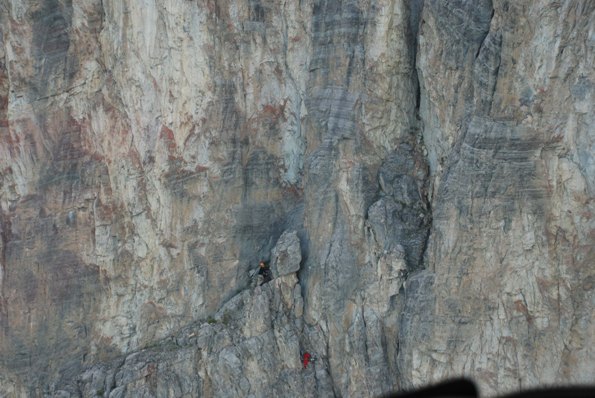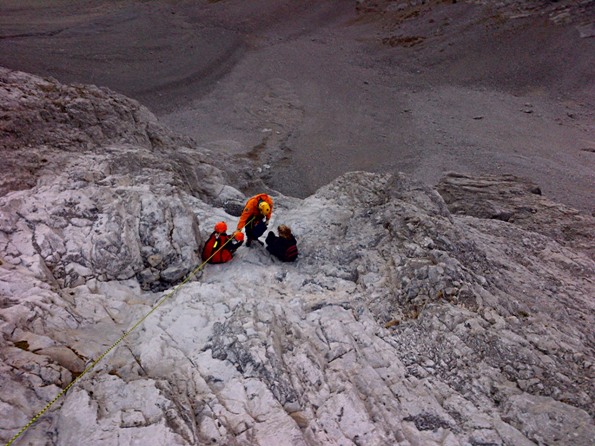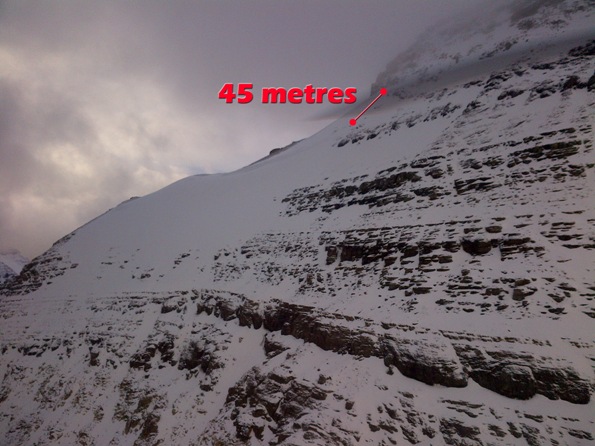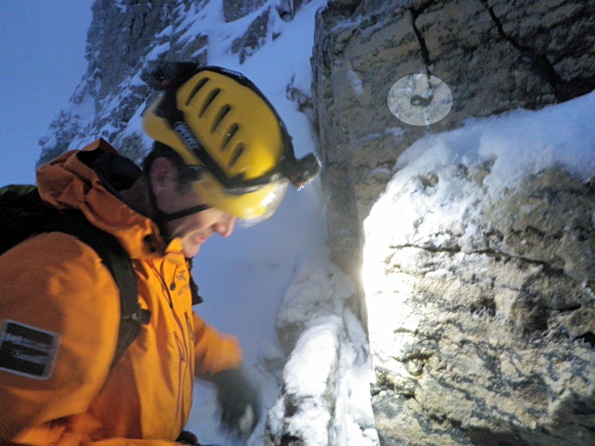Accident Reports - September 2012
Mountain safety
Rockfall Incident on “Shuftee”, Mount Yamnuska, Kananaskis, Sept 17, 2012
Stranded Scramblers, Cascade Mountain, Banff National Park, Sept 17, 2012
Stranded Climber, East Face, Mount Victoria, Banff National Park, Sept 9, 2012
Rockfall Incident on “Shuftee”, Mount Yamnuska, Kananaskis, Sept 17, 2012
Parks Canada Visitor Safety was called to assist Kananaskis Public Safety for a climber who had been struck by falling rock, 2 pitches below the summit of Yamnuska. The party of 4 had intended to climb the route Diretissima but had gone off route. One of the lead climbers was approximately 30m up when a block he was on “the size of a mini fridge” gave way. He had a camming device behind the block which came out and he fell 10m with the block onto another camming device. The belayer saw the fall and the block coming, wrapped the rope around his leg and braced for impact. The rock broke in two and hit the belayer on the back and head, knocking him out, and severely damaging the rope. The fallen leader quickly made an anchor, fixed the climbing rope, and descended to the belayer on prussiks, while the other party above descended to help. They called Kananaskis Public Safety who instructed them to stay put and help was on the way. The belayer regained consciousness eventually, but was bleeding profusely from his head. 
Kananaskis Public Safety and 2 Banff Visitor Safety Specialists arrived on scene by helicopter. After a reconnaissance, one Visitor Safety Specialist was slung onto the sloping ledge with a 200 ft. longline, which is twice the usual length. This gives the pilot more room to manoeuvre and stay a safer distance from the wall. There was approximately 30 minutes of daylight available for flying. Once inserted, the rescuer drilled a bolt anchor, and the rescuer and patient were heli- slung off the face using an anchor release technique. The remaining climbers were given headlamps, and were able to self evacuate up the route and walk off.
Analysis
- The climbers realized they had strayed off of their intended route, but had a guidebook telling them which route they had gotten onto. At that point it was easier to continue up than go back down onto Diretissima.
- The last 2 pitches of Shuftee (like many Yamnuska routes) are known to be very loose. The lead climber said he kicked and tapped the block numerous times before committing to climbing it. Loose rock is unavoidable, so try to have the belayer better situated off to the side or under an overhang, and avoid placing protection behind loose features.
- The belayer luckily had the forethought to wrap the rope around his leg before impact. If he hadn’t, the outcome could have been much worse as the lead climber would have fallen much further.
- The party had a cell phone, knew who to call, and remained calm, helping the rescuer tidy the area of ropes and gear as well as handle the injured climber.
- The other members of the party were able to climb out with headlamps, avoiding a long night on the wall.
Stranded Scramblers, Cascade Mountain, Banff National Park, Sept 17, 2012
Two inexperienced scramblers in their twenties went up the normal route up Cascade Mountain, starting from the Mount Norquay parking lot in Banff. They made it to the summit just after midday, but on their way down, they missed the trail and ended up going down the wrong way onto the NW facing “amphitheatre”. This is a face with steep, exposed rock slabs and very loose ground, considered to be climbing terrain. They continued down, making it to within 200m of walking terrain when they decided to call for help. They had also separated from each other while down climbing.
Visitor Safety was notified by cell phone from one of the scramblers of their predicament. It was now dark, so a helicopter and rescue party could not be dispatched until morning. They were told to stay in place and to not move. In the morning, 2 visitor safety specialists were inserted via helicopter longline. The 2 scramblers had reunited and had moved onto some exposed slippery slabs above a steep cliff. An anchor was made above them, and a specialist was lowered to put harnesses on them. They were then belayed up to a ledge and longlined off of a better ledge. They were both uninjured. 
Analysis
- The party did not recognize the proper way down. Make sure that on the way up you look back to recognize features and landmarks. There are many stray trails from people getting lost, and it is easy to get lost if you aren’t paying attention.
- The party did not go back up to the proper trail once they realized it was the wrong way. Error correction could have saved the actual rescue from happening.
- They separated on the descent. One of the stranded could call for help on their cell phone (403) 762-4506, but was unsure as to where the other member was.
- Pack for emergencies. Luckily there was an inversion, where it was near freezing in the valley bottom, but warmer up high where the party was. The stranded had only light summer clothing, running shoes and no headlamps.
- The party was asked to stay in place and not to move. The party had actually moved from a good ledge into a more precarious position.
- Parks Canada has a photo map of that particular scramble. On it, common error points of scramblers are clearly marked. They are available at all Parks Canada information centres.
Stranded Climber, East Face, Mount Victoria, Banff National Park, Sept 9, 2012
An inexperienced party of two decided to turn around before making the summit of Mt. Victoria. On their descent, the female member of the climbing team fell and slid down the NE face for approximately 45m. She miraculously managed to self arrest. Her climbing partner was unable to assist her. He went down to the hut and called Banff Dispatch. 
The stranded climber fell 45m before self-arresting on the snow/ice-covered East Face of Mt Victoria
A team of two Visitor Safety Specialists was dispatched from Banff. They made several unsuccessful attempts to access the stranded climber’s location. Due to poor visibility and strong winds, they were forced to land at the Plain of Six Tea House. Eventually, they returned to Lake Louise to re-fuel, and then made a successful trip to get the team members into Abbot’s Pass. The two rescuers were able to climb up and meet the male (and un-stranded) member of the climbing team. They left him at that location and continued up, searching for the stranded climber. They made voice contact at nightfall. The rescuers placed a piton anchor in the rock above the patient, who was found 45m below ridgeline on the NE face. One rescuer was lowered down and clipped into the stranded climbers harness. The rescuer and stranded climber were then belayed back up to the ridgeline. From here, the rescue team guided the uninjured climber back down to her climbing partner, now, in complete darkness. Each rescuer guided one member of the climbing team down to Abbott’s Pass hut, where they all spent the night. The next day, a helicopter picked up the climbers, along with the rescuers, and flew them back to Lake Louise. 
A Visitor Safety Specialist builds a piton anchor for lowering a rescuer to the stranded climber
Analysis
The climbing party admitted that they were unprepared and under-experienced to climb Mt. Victoria. Equally important, when things went wrong, they lacked the skills to be able to rectify their situation. Furthermore, they explained that they had learned about climbing from reading books. The lack of formal instruction and/or genuine mentorship from an experienced person was the major contributing factor that lead them into the predicament on Mt. Victoria. Climbers, new to the activity, are highly encouraged to seek proper instruction from an ACMG guide. For financially restricted individuals, the Alpine Club of Canada is a place to meet experienced individuals where some mentorship can take place.
- Date modified :